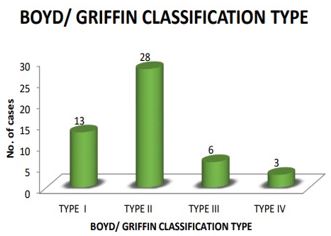Comparative study between dynamic hip screw and trochanteric femoral nail in intertrochanteric femur fracture
Abstract
Introduction: The incidence of intertrochanteric fracture has been rising with an aging population in many parts of the world and the number of hip fractures is expected to increase year after year. Reduction of fracture is the goal of treatment so that near anatomic alignment and normal femoral anteversion are obtained. Surgical treatment with stable reduction and fixation allows early mobilization and reduces complications. There are two main types of fixations for intertrochanteric fractures- the extramedullary plate fixation and intramedullary nail.
Aims and Objective: The main objective of this study was to compare outcome of Dynamic Hip Screw and Trochanchanteric Femoral Nail in patients of intertrochantric femur fracture.
Material and Methods: In this study, 50 patients of intertrochanteric fracture were admitted and randomly divided into two groups. 25 patients operated with Dynamic Hip Screw and other 25 were undergone Trochanteric Femoral Nail fixation. Outcome after the surgery such as average duration of surgery, blood loss, hospital stay and functional outcome were assessed using Harris Hip Score.
Results: The study findings reveal that there was a significant difference in mean operative time between both study groups with p<0.05. Hence in dynamic group mean operative time was 2.26±0.44 hours and in trochanteric femoral nailing mean operative time was 1.96±0.2 hours. Blood loss was more significant in patients with DHS as compared with TFN p<0.05. In dynamic group mean Harris score was 81.76±9.49 and in trochanteric femoral nailing mean Harris score was 87.12±7.74.
Conclusion: Surgical management of intertrochanteric fractures is the preferred treatment to avoid complications of prolonged immobilization. Dynamic Hip Screw (DHS) has been the gold standard. Our study indicates that TFN may be better choice when compared to DHS in unstable intertrochanteric fractures.
Downloads
References
2. Cummings SR, Rubin SM, Black D. The future of hip fractures in the United States. Numbers, costs, and potential effects of postmenopausal estrogen. Clinical Orthopaedics and Related Research. 1990; 252:163-166.
3. Bridle Sh, Patel AD, Bircher M, Calvert PT (1991) Fixation of intertrochanteric fractures of the femur: a randomised prospective comparison of the gamma nail and the dynamic hip screw. J Bone Joint Surg [Br] 73:330–334.
4. Halder SC (1992) The Gamma nail for peritrochanteric fracture. JBone Joint Surg [Br] 74:340–344 T. Brammar et al. Reverse obliquity and transverse fractures of the trochanteric region of the femur; a review of 101 cases; Injury; 2005.
5. Cooper, Campion, G. Campion, and LJ 3rd Melton. "Hip fractures in the elderly: a world-wide projection." Osteoporosis international a. (1992): 285-289. Simmermacher RK, Bosch AM, Van der Werken C.
6. Sadowski C, Lu bbeke A, Saudan M, Riand N, Stern R, Hoffmeyer P. Treatment of reverse oblique and transverse intertrochanteric fractures with use of an intramedullary nail or a 95 degrees screwplate: a prospective randomized study. J bone Joint Surg Am 2002;84(3):372-81.
7. Cooper A. Sir Astley Cooper on Fracture of the Neck of the Femur. The Boston Medical and Surgical Journal. 1834;10(21):332-334.
8. Subhadip Mandal et al. (2015) “Comparative Analysis of the Results of Trochanteric Femoral Nail and Dynamic Hip Screw in Treatment of Comminuted Unstable Trochanteric Fractures – a Prospective Randomised Controlled Trial on Indian Population”, Journal of Indian Orthopaedic Rheumatology Association July-December 2015:1(1);12-19.
9. S. Mandal, U. Banerjee, A.S. Mukherjee, P. Saha, S. Mandal, S. Kund (2019) “Results of “Trochanteric Femoral Nailing (TFN)” in comminuted unstable trochanteric fractures”, Acta Orthopedica Belgica, Vol. 85 - 4 – 2019
10. Bridle SH, Patel AD, Bircher M, et al. Fixation of intertrochanteric fractures of the femur. A randomised prospective comparison of the gamma nail and the dynamic hip screw. J Bone Joint Surg Br. 1991; 73: 330 – 334
11. Beinkowsky P, Reindl R, Berry G K, Harvey E J (2006): A new intramedullary devices for the treatment of inter trochanteric hip fractures; J Trauma; 2006 Dec; 61(6): 1458- 62.
12. H M Klinger, HM Baums, M Eckert, and R Neugebauer (2005): A comparative study of unstable per and intertrochanteric femoral fractures with DHS and PFN and TSP; Zentralbl chir, 2005 130.
13. J. Pajarinen, J Lindahl, O Michelson, E Hirvensalo (2005): Pertrochanteric femoral fractures treated with a dynamic hip screw or a proximal femoral nail; jbjs, vol 87-B, 76-81.
14. Hu W, Luo Y, Fang H (2006): comparision of various kinds of internal fixation in unstable intertrochanteric fracture; Zhongguo Xiu Fu Chong 2006 July;20(7): 690-4.

The entire contents of the Orthopaedic Journal of Madhya Pradesh Chapter are protected under Indian and International copyrights. Orthopaedic Journal of Madhya Pradesh Chapter allow authors to retain the copyrights of their papers without restrictions, Authors grant the publisher the right of exclusive publication. The Journal then grants to all users a free, irrevocable, worldwide, perpetual right of access to, and a license to copy, use, distribute, perform and display the work publicly and to make and distribute derivative works in any digital medium for any reasonable non-commercial purpose, subject to proper attribution of authorship. The journal also grants the right to make numbers of printed copies for their personal non-commercial use under Creative Commons Attribution-Non-commercial share alike 4.0 International Public License.

 OAI - Open Archives Initiative
OAI - Open Archives Initiative












